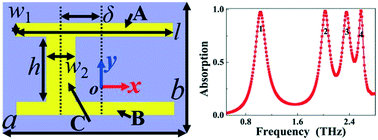Quad-band terahertz metamaterial absorber enabled by an asymmetric I-type resonator formed from three metallic strips for sensing application
Abstract
A quad-band metamaterial absorber operating in the terahertz region is demonstrated in this paper. The basic cell of the device consists of three metallic strips (forming an asymmetric I-type resonator) placed on both layers of an insulating medium slab and a metallic ground plane. The asymmetric I-type resonator can interact strongly with the incident beam, resulting in four distinct absorption peaks with nearly 100% absorbance. The underlying mechanism of the quad-band absorption is investigated with the aid of their near-field distributions resulting from the calculation results of the numerical simulation. Results further prove that the four distinct absorption peaks exhibit large dependence on the dimension changes of the asymmetric I-type resonator (or three metallic strips). Based on this, we design a kind of terahertz metamaterial absorber which can effectively control the number of absorption peaks by replacing one of the metallic strips with photosensitive silicon. It is revealed that the number of absorption peaks can be adjusted from the dual-band to the quad-band when an external stimulus changes the conductivity of the photosensitive silicon. These absorption properties should have great application prospects in terms of thermal imaging, Raman enhancement, sensing and detection, etc.



 Please wait while we load your content...
Please wait while we load your content...